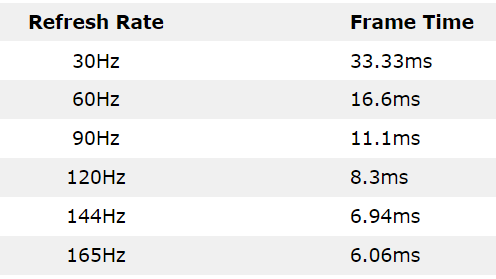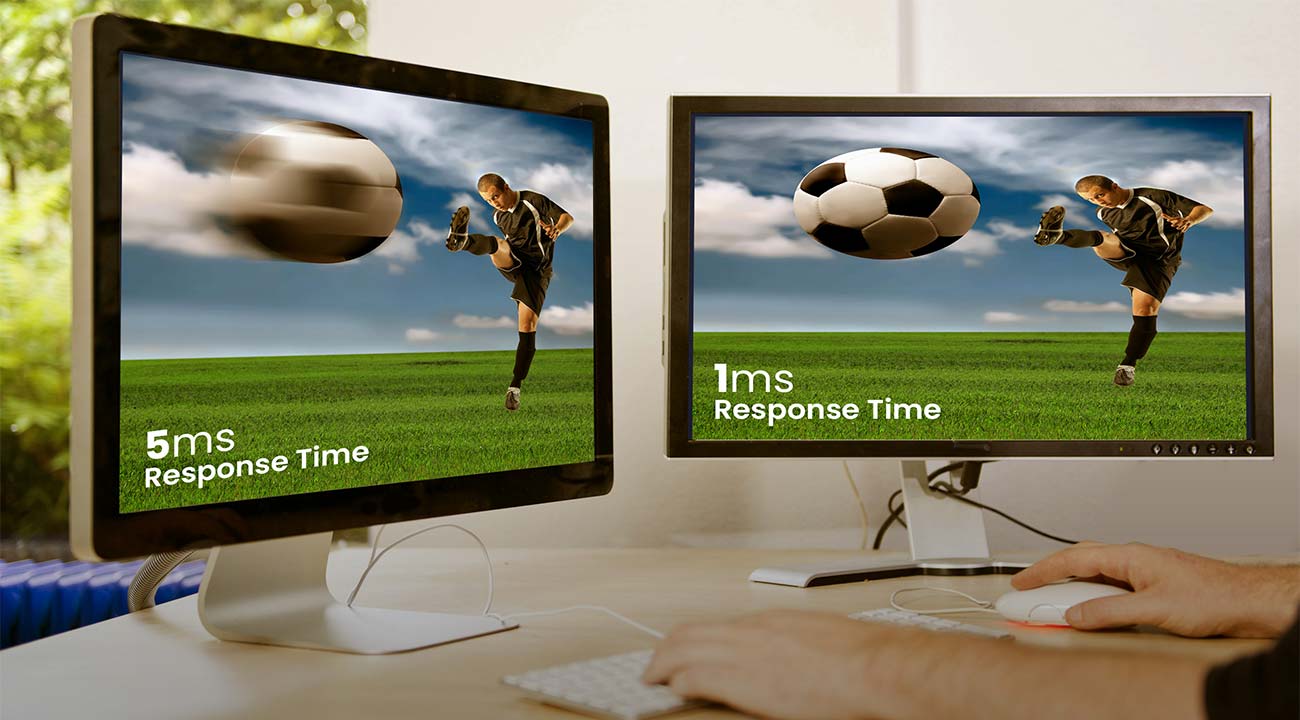When buying a gaming monitor for your rig, one of the most important factors that you need to consider is the response time. This aspect is very important for professional gamers who play competitive games where reaction time matters a lot.
Most gaming displays that are currently available on the market come with 1ms to 5ms response time. And with so many options to choose from, you may wonder which one you should get and how it will impact your gaming experience.
Simply put, monitors with a 1ms response time are five times faster than monitors with a 5ms response time. However, this difference is not possible to notice with the human eye. Unless you are a pro gamer, this subtle difference will not affect your experience.
Now, you may have some questions regarding response time, like, why it matters, how to check it, and many more. In this article, we will try to address all your concerns to help you get the best monitor for your needs.
Let’s get started!
What is Response Time?
The response time of a monitor measures the amount of time it takes to change the properties of a pixel. In other words, it measures how long your screen takes to turn a pixel from one color to another. The lower the response time, the more responsive your monitor will be to your actions.
Response time is measured in milliseconds—the lower the measure, the better the display quality. When a monitor brand mentions its products’ response time, it usually lists its Black-to-White-to-Black or Gray-to-Gray (GtG) response times. As a result, the recorded measure indicates how long the screen takes to turn pixels from one shade of gray to another.
Why is Response Time Important?
Your monitor’s response time affects your user experience, but the difference is very subtle. Usually, displays with a response time of around 10ms are good enough in most cases, such as studying and web surfing. However, for avid gamers, the lowest response time allows them to perform at their peak in e-sport games.
Pro gamers usually require the quickest responsiveness for the best performance. A high response time results in problems such as blurring, ghosting, and slightly slower movement. This makes a massive difference for professional gamers. On the other hand, graphic designers and video editors need the best color accuracy and image quality, which are produced better with monitors having 10ms or higher response times.

How to Check Response Time?
A monitor’s response time is usually mentioned in its specification list. So, you can check it there. Alternatively, you can run response time tests online through several websites.
You can find the specification list on the brand’s website or product description. It is also printed on the package and the manual.
However, if you do not have the package and manual, or know enough information to find your monitor’s specification on the internet, you can try checking the response time online. Eizo Monitor Test, TestUFO, and DisplayHZ are some of the most popular websites where you can run a GtG response time test.

1ms vs 5ms: What Are the Differences?
Monitors with 1ms and 5ms response times offer a very similar user experience. But the slight difference in responsiveness can significantly impact the performance of gamers. 5ms monitors are five times slower in responsiveness than 1ms monitors, but they produce better color accuracy.
Even if you are a casual gamer, 5ms monitors are a good choice. Both 1ms and 5ms monitors have minimum blur occurrences and fractions. Moreover, both offer an almost similar level of color and display quality.
The differences between the two response times are discussed below.
Responsiveness
The main difference will be noticeable when you will need a faster change in the display after your command. For example, let’s say you are playing a first-person shooter game where you need to turn your character to the left. When you give this command through the keyboard or controller, the monitor receives this data and updates the resulting image. This update will be done in one millisecond by a 1ms monitor and in five milliseconds by a 5ms monitor. Since it happens all in milliseconds, this delay is undetectable in most cases.
Panels
Another difference is in the monitors’ panels. 1ms response time is more common in monitors that come with TN panels. Therefore, TN panels respond much faster and can work with 240Hz refresh rates. However, TN panels with 1ms response time also take the lowest time in pixel processing, resulting in a lower level of color accuracy. And this is how they keep the speed high. They are popular among avid gamers who play reflex-based games.
On the other hand, 2ms to 5ms response times are more common in VA and IPS panels. Their response time is slightly slower, but they render better colors and viewing angles. Therefore, IPS and VA panels require more time in pixel processing. The delay translates to a higher response time. However, some newer gaming monitors with IPS and VA panels have a 1ms response time as well.

Screen Size and Resolution
Generally, displays with bigger screens and higher resolutions have higher response times. This is because when you have a large screen, the signals go further through the power and processing sources to display the result of your command on the monitor. Moreover, the higher the resolution, the more pixels your screen has to update.
Therefore, 5ms and higher response times are more common on larger monitors offering high resolutions. However, as technology is advancing fast, more monitors are starting to enter the market where large screens, higher resolutions, and faster response times are incorporated to work together.
Refresh Rate
Many people consider response time and refresh rate to be the same. But that is not the case. The refresh rate indicates the number of images your monitor can draw per second. In other words, refresh rates measure how many times your monitor can refresh an on-screen image. It is measured in Hertz (Hz).
Whether your monitor’s refresh rate is 60Hz or 144Hz, the longer the response time is, the more noticeable the blur will be. Therefore, the blur during movements is more apparent on 5ms displays. So, if you want the ultimate visual experience in gaming, go for a monitor with the lowest response time and the highest refresh rate, as per your budget of course.

1ms vs 5ms: Making The Right Choice
If you need an incredibly fast response time, 1ms panels will be the best choice for you. However, a 5ms monitor gives you almost the same experience except in a few cases. Therefore, in the end, it boils down to what you need the monitor for.
For conventional office work, web surfing, and studying, the difference between the performance of a 1ms and 5ms monitor won’t have any impact. Your experience is most likely to be identical with both response times. Hence, you can go for any of these panels. You can also opt for cheaper options with a higher GtG response time if you are on a budget.
However, response time delays, even at milliseconds, can make a huge difference in competitive games that are reflex-based, such as Counter-Strike, Valorant, Call of Duty, etc. Therefore, if you are a professional gamer who regularly plays these fast-paced games and take your own performance very seriously, go for 1ms monitors to ensure the best results.

But if you are more of a casual gamer and play less competitive games where movement and reflexes don’t matter as much, a 5ms response time will work just fine. In this case, you can experience enhanced visuals with better color accuracy and viewing angles.
Now, what if you want to stream your games? Usually, 5ms panels will suffice for streaming. However, again, if you are streaming fast-paced games in HD quality, a faster screen can reduce the lag and motion blur during your stream. Therefore, in this case, choosing a 1ms monitor is the safest option.
1ms vs 5ms: Which One Is Better?
In short – “As you can see, there is no direct resolution to the debate of 1ms vs 5ms response time. Based on your needs and preferred user experience, you need to choose between which one would best suit you. At the same time, consider other factors such as panels, refresh rates, screen size, and resolution. Based on all these considerations, your budget, and your expectations, choose the one that offers you the best value for your investment.”







